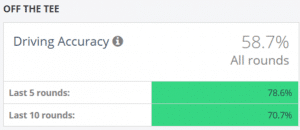Golf Driving Accuracy
Driving accuracy is defined as “The percentage of time a tee shot comes to rest in the fairway (regardless of club)”.

It is a binary statistic, meaning that it is simply checking to see if the fairway was successfully hit or not. This means that it fails to capture some important nuances that happen during a normal round of golf, such as how far the tee shot was hit, and the severity of the miss. Here are some examples:
- Player A hits a 300-yard drive in the middle of the fairway. This is a successful fairway hit. Player 2 hits a pitching wedge from the tee that travels 130 yards and lands on the fairway. This is also a fairway hit. The ‘Driving Accuracy’ statistic doesn’t account for the differences in distance hit as it just looks at whether or not the fairway was hit or not.
- Player A hits a 300-yard drive and just misses the fairway by one inch, but has a great lie. This counts as a missed fairway. Player B hits an awful snap-hook out of bounds. This also counts as a missed fairway. Both of these shots count as missed fairways despite the fact that they were widely different in what end result they generated.
Driving accuracy is still a useful statistic, since it gives a player a quick understanding of how many fairways he hit. However, it should be used as a supplementary stat since there are so many other factors that come in to play, such as this stat’s inability to factor in the severity of the misses as well as the driving distance hit. Furthermore, the firmness and width of the fairways are important factors to consider as well although the effect on individual rounds are mitigated with a large sample size.
For a more detailed discussion on driving distance, check out this blog post.

